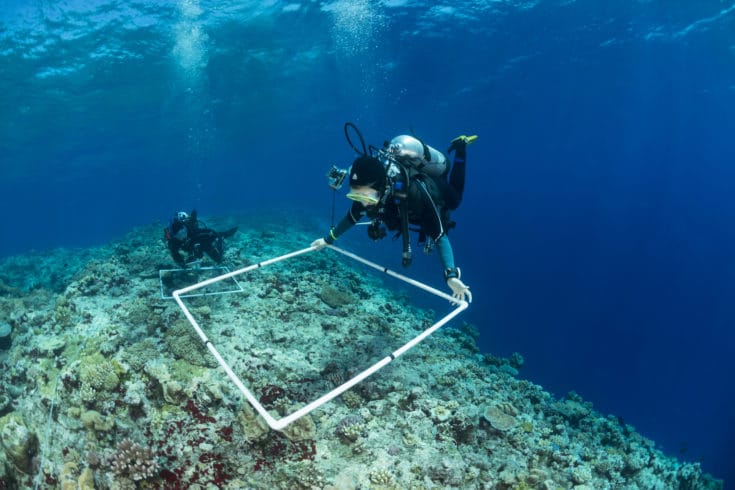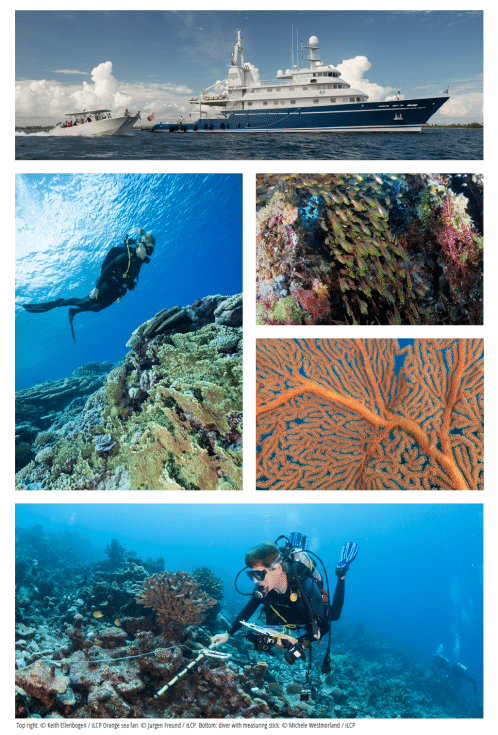
In 2011, scientists from the Khaled bin Sultan Living Oceans Foundation set out on a mission to explore the remote coral reefs of the world. An international team of scientists, photographers, videographers and conservationists, as well as local leaders, were assembled to map, characterize, and evaluate coral reefs throughout the western Atlantic, Pacific, and Indian Oceans. They wanted to take a snapshot of the reefs in time, to survey and map the reefs and assess their health before it was too late.
Coral reefs are in crisis. We’ve already lost half of the world’s coral reefs in the past 50 years. Current models predict that we are likely to lose most of the other half before the turn of the century. Corals are threatened by a variety of factors including global warming, ocean acidification, overfishing, pollution, development, and disease—all of which appear to be getting worse.
CORAL REEFS: A KEYSTONE ECOSYSTEM
One of the reasons the Foundation was interested in studying coral reefs, is that they are considered a keystone ecosystem for assessing the health of the entire ocean. Although they occupy less than one quarter of one per cent of the marine environment, more than a quarter of all known marine fish species spend at least part of their lives in these delicate habitats. It is estimated that one out of every seven people around the world depends on coral reefs for food or income, so their impact on people far outstrips their relatively small size.
The grand idea behind the Global Reef Expedition is to get a baseline assessment of coral reef health around the world, and to hopefully find places resilient to change. The expedition specifically chose to explore remote reefs far from civilization, particularly those relatively free from human influence, but we also surveyed the health of reefs that were close to port and heavily fished. Comparing the health and ecological condition between remote and relatively pristine coral reefs with those that have been compromised by chronic stress from human use will enable us to identify high-priority sites for protection. Our ultimate goal is to use all of this information to create models of coral reef health and resiliency, so that we could identify places in need of protection, and those most likely to weather the forecasted coral apocalypse.
As part of our studies, we were able to access remote reefs to conduct scientific research with the use of the Golden Shadow, a 219 ft (66.7 metres) yacht with dedicated laboratory facilities, a diving recompression chamber, and an onboard aircraft—the Golden Eye—that was used extensively for aerial surveys of coral reefs. This modern and advanced research vessel was made available to the Foundation through the generous support of His Royal Highness Prince Khaled bin Sultan of Saudi Arabia, who donated the use of his ship for the Global Reef Expedition.
A GLOBAL JOURNEY RESEARCHING OVER ONE THOUSAND REEFS AND INVOLVING OVER 200 SCIENTISTS
Over the course of five years, our scientists nearly circumnavigated the globe on the research vessel M/Y Golden Shadow as they studied over 1,000 coral reefs in 15 countries and 97 islands on the Global Reef Expedition. Many of the reefs visited on the expedition had never been studied before. Along the way they recorded nearly 500 different species of coral, 1500 species of fish, and conducted over 11,000 surveys of what lived on the reef and covered the seafloor.

To develop the new model to accurately map coral reef and other tropical shallow-water marine habitats, scientists took data collected from extensive SCUBA surveys conducted on the Global Reef Expedition and extrapolated that information across the entire reef using ultra-high-resolution satellite imagery. By comparing the maps with video footage from cameras dropped at precise coordinates along the reef, the scientists were able to verify the accuracy of their new mapping method.
On this epic voyage we witnessed coral bleaching first-hand on pristine reefs in the Indian Ocean, explored the little-known cold-water coral reefs of the Galápagos Islands, and conducted what was likely the last survey of healthy reefs in northern reaches of the iconic Great Barrier Reef. Our first stop on the Global Reef Expedition was in The Bahamas, where we wanted to see how coral reefs were coping with the triple threats of climate change, coral disease, and loss of many of their keystone species.
We then traveled to Jamaica and teamed up with local fishermen and conservation organizations to help them establish a fishing sanctuary to preserve local fisheries for current and future generations. Our research eventually took us down through the Caribbean, and across the South Pacific, where we came upon many healthy and ancient coral reefs, a giant swarm of sharks, and indigenous communities who protected their reefs with rules set forth by traditional leaders centuries ago.
In addition to conducting research, we spent time with local communities to explain our research, share our results, and listen to hear how they use the reef and what changes they have seen on the reef over their lifetimes. We brought along teachers and educators to teach local students about coral reefs, and award-winning filmmakers and photographers to capture the journey and document what we saw underwater. Nearly 200 scientists from around the world participated in the Global Reef Expedition, lending their expertise and knowledge of the local reefs.
THE FIRST GLOBAL CORAL REEF ATLAS
Scientists on the expedition also mapped and surveyed the reefs down to a one-square-meter scale to better understand their health and resiliency. In the process they developed a new method to accurately map coral reefs using a combination of Earth-orbiting satellites and field observations. Last month they published the first global coral reef atlas, which contains maps of over 65,000 square kilometres (25,097 square miles) of coral reefs and surrounding habitats—by far the largest collection of high-resolution coral reef maps ever made.
The high-resolution coral reef maps they created contain detailed information on the location and depth of different parts of the coral reef (such as the reef crest, fore reef, back reef, and lagoonal reef) visited on the expedition, as well as information on the size of seagrass beds and mangrove forests along the coast. All of these coastal habitats are key components of tropical coastal ecosystems and help to filter water, protect the coast from storms, and provide nursery habitat for commercial and subsistence fisheries.
Now, we have completed the fieldwork for the Global Reef Expedition and our scientists are hard at work analyzing the data. By comparing assessments of coral reef biodiversity, oceanographic conditions, and human pressures, we can reliably describe the status of coral reef health, identify major threats, and determine processes and factors that control the health and resilience of coral reef ecosystems worldwide.
We are working across vast geographic scales in order to see what factors are most important to maintaining the structural integrity and health of reefs, which will be used to make predictions regarding the future health of coral reefs, including their capacity to adjust to climate change. The data will generate science-based tools and decision aids that can also be used to mitigate the threats to these life-supporting marine ecosystems.
As we continue to analyze and understand the data we collected on the Global Reef Expedition, we aim to provide applied scientific knowledge to local resource managers and relevant government officials, bridging science with management to achieve our long-term goal of ensuring health and sustainable coral reef ecosystems around the globe. With this research, we hope to provide knowledge of the critical ecosystem components that promote coral reef resilience and produce effective reef management tools that will influence policy and resource management actions urgently needed to improve and sustain the health of coral reefs around the world.
This story was first published in the Fall 2019 issue of Global Geneva Magazine.
Main Photo: © Keith Ellenbogen/iLCP, from research conducted on the Global Reef Expedition on the Great Barrier Reef